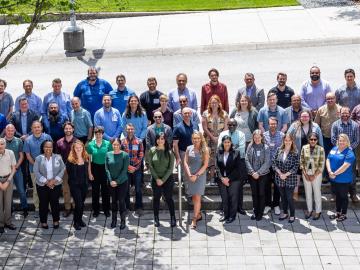
Filter News
Area of Research
- Biological Systems (1)
- Biology and Environment (26)
- Clean Energy (23)
- Computational Biology (1)
- Electricity and Smart Grid (1)
- Fuel Cycle Science and Technology (1)
- Fusion and Fission (18)
- Fusion Energy (4)
- Isotopes (7)
- Materials (16)
- National Security (28)
- Neutron Science (8)
- Nuclear Science and Technology (16)
- Supercomputing (35)
News Type
News Topics
- (-) Big Data (27)
- (-) Biomedical (29)
- (-) Clean Water (14)
- (-) Frontier (25)
- (-) Grid (25)
- (-) Mercury (7)
- (-) National Security (39)
- (-) Nuclear Energy (55)
- (-) Space Exploration (12)
- 3-D Printing/Advanced Manufacturing (42)
- Advanced Reactors (8)
- Artificial Intelligence (48)
- Bioenergy (51)
- Biology (60)
- Biotechnology (11)
- Buildings (19)
- Chemical Sciences (25)
- Climate Change (50)
- Composites (8)
- Computer Science (87)
- Coronavirus (17)
- Critical Materials (4)
- Cybersecurity (14)
- Decarbonization (46)
- Education (1)
- Emergency (2)
- Energy Storage (29)
- Environment (104)
- Exascale Computing (27)
- Fossil Energy (4)
- Fusion (31)
- High-Performance Computing (45)
- Hydropower (5)
- Isotopes (27)
- ITER (2)
- Machine Learning (22)
- Materials (43)
- Materials Science (46)
- Mathematics (7)
- Microelectronics (2)
- Microscopy (20)
- Molten Salt (1)
- Nanotechnology (16)
- Net Zero (8)
- Neutron Science (47)
- Partnerships (18)
- Physics (29)
- Polymers (8)
- Quantum Computing (21)
- Quantum Science (30)
- Renewable Energy (1)
- Security (11)
- Simulation (32)
- Software (1)
- Statistics (1)
- Summit (31)
- Sustainable Energy (47)
- Transformational Challenge Reactor (3)
- Transportation (27)
Media Contacts

The world’s fastest supercomputer helped researchers simulate synthesizing a material harder and tougher than a diamond — or any other substance on Earth. The study used Frontier to predict the likeliest strategy to synthesize such a material, thought to exist so far only within the interiors of giant exoplanets, or planets beyond our solar system.
Joe Tuccillo, a human geography research scientist, leads the UrbanPop project that uses census data to create synthetic populations. Using a Python software suite called Likeness on ORNL’s high-performance computers, Tuccillo’s team generates a population with individual ‘agents’ designed to represent people that interact with other agents, facilities and services in a simulated neighborhood.

Power companies and electric grid developers turn to simulation tools as they attempt to understand how modern equipment will be affected by rapidly unfolding events in a complex grid.

Researchers at the Department of Energy’s Oak Ridge National Laboratory and partner institutions have launched a project to develop an innovative suite of tools that will employ machine learning algorithms for more effective cybersecurity analysis of the U.S. power grid.

Brian Sanders is focused on impactful, multidisciplinary science at Oak Ridge National Laboratory, developing solutions for everything from improved imaging of plant-microbe interactions that influence ecosystem health to advancing new treatments for cancer and viral infections.

ORNL hosted the Mid-South Regional Chapter of the American Society for Photogrammetry and Remote Sensing, or ASPRS. Participants spanning government, academia and industry engaged in talks, poster sessions, events and workshops to further scientific discovery in a field devoted to using pictures to understand changes to the earth’s inhabitants and landscape.

A newly established internship between ORNL and Maryville College is bringing cybersecurity careers to a local liberal arts college. The internship was established by a Maryville College alumni who recently joined ORNL.

In the wet, muddy places where America’s rivers and lands meet the sea, scientists from the Department of Energy’s Oak Ridge National Laboratory are unearthing clues to better understand how these vital landscapes are evolving under climate change.

As a data scientist, Daniel Adams uses storytelling to parse through a large amount of information to determine which elements are most important, paring down the data to result in the most efficient and accurate data set possible.

SCALE users from 85 organizations across 21 countries gathered online and in person at Oak Ridge National Laboratory from June 5 to June 7 for the Eighth Annual SCALE Users Group Workshop. The meeting included 32 presentations and 14 hands-on tutorials on impactful and innovative applications of SCALE.


